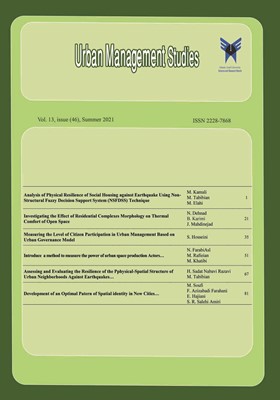Introduce a method to measure the power of urban space production Actors(Proposing criteria and indicators for measuring the power of actors)
Subject Areas : Urban Management StudiesNayyer Farabiasl 1 , Mojtaba Rafieian 2 , Mohammadreza Khatibi 3
1 - PhD student in Department of Urban Planning, Faculty of Architecture and Urban Planning, Qazvin Branch, Islamic Azad University, Qazvin, Iran
2 - Department of Urban Planning Faculty of Art and Architecture Tarbiat Modares University
3 - Assistant Professor, Department of Urban Planning, Faculty of Architecture and Urban Planning, Qazvin Branch, Islamic Azad University, Qazvin, Iran. Khatibimohammadreza@gmail.com
Keywords: power, Actors, Criteria and Indicators, Measuring Power,
Abstract :
Introduction & Objective: Urban space production is a complex concept that has been studied by different thinkers from different angles. Power is one of the main factors influencing the production of urban spaces. This research seeks to determine the criteria and indicators and provide a method for measuring the power of actors in the production of urban spaces.Research Method: The present study is fundamental according to the purpose of the research and descriptive-exploratory according to the research question. Documentary and semi-structured interviews were used to collect data. Sampling was performed using snowball method to reach the subject experts. Analytic Network Process (ANP) and SuperDecision software were used to analyze the data.Statistical population: In this research, a community of urban planning experts and officials and executive experts in the public, semi-public and private sectors (including 30 people) has been conducted.Findings: Criteria and indicators for measuring the power of urban space production actors have been identified and by analyzing the network, the weight of each has been obtained and a method for measuring the power of actors in the form of a scoring table has been developed.Conclusion: This study was conducted in order to develop the methodology of power relations analysis of urban space production actors. According to the obtained results, the criterion of “access to power resources”, has the highest weight among the criteria of power of actors, and the criteria of “influence in space” and the “degree of participation and presence in space” are in the next category of importance.
ادل، ماتیو. (1380). اقتصاد سیاسی شهری و منطقهای. ترجمه فریبرز رئیس دانا. تهران: نشر قطره.
-اسحاقی، سید حسین. (1384). نگاهی به پدیده رانت و رانت جویی در ایران، فصلنامه رواق اندیشه، شماره 45 صص21-32.
بلاملی، نیکلاس. (1397). قلمرویی شدن مالکیت زمین: فضا، قدرت و پرکتیس. ترجمه همن حاجی میرزایی، فضا و دیالکتیک، شماره 9، پاییز 1397.
موسویان شریف زاده، سید مجتبی. (1392). مطالعه نحوه تأثیر قدرت بر فضاهای عمومی شهری. نمونه موردی:پارکهای شهر تهران در 5 دهه اخیر. پایاننامه کارشناسی ارشد شهرسازی طراحی شهری، دانشگاه آزاد اسلامی تهران مرکز. دانشکده هنر معماری شهرسازی.
فارابی اصل، نیر. (1400). تبیین روابط قدرت کنشگران تولید و بازتولید فضای شهری تهران-نمونه اراضی عباسآباد، رساله دکترای شهرسازی. دانشگاه آزاد اسلامی واحد قزوین.
فارابی اصل، نیر، رفیعیان، مجتبی، خطیبی، سید محمدرضا. 1400. تبیین روابط قدرت کنشگران در تولید و بازتولید فضاهای شهری با تاکید بر اراضی عباسآباد تهران. فصلنامه مطالعات محیطی هفت حصار. همدان. شماره 37. پاییز.
هیلیر، جین. (1388). سایههای قدرت(حکایت دوراندیشی در برنامهریزی کاربری اراضی)، ترجمه کمال پولادی، تهران: جامعه مهندسان مشاور ایران
کلگ، استوار. آر. (1383). چهارچوبهای قدرت، مترجم: مصطفی یونسی.تهران: پژوهشکده مطالعات راهبردی
کاظمیان، غلامرضا. (1383). تبیین رابطه ساختار حاکمیت و قدرت شهری با سازمانیابی فضا-تلاش برای طراحی مدل نمونه منطقه کلانشهری تهران-رساله دکترا، دانشگاه تربیت مدرس.تهران
کاظمیان، غلامرضا، جلیلی، سید مصطفی. 1394. تحلیل قدرت ذینفعان کلیدی در فرایند سیاستگذاری طرح جامع تهران(1378-1390)، دو فصلنامه دانشگاه هنر، نامه معماری و شهرسازی، شماره 15، زمستان
کاویانی راد، مراد (1394). رویکردی نو در بازتعریف جغرافیای سیاسی. پژوهشهای جغرافیای انسانی، دورة 47، شمارة 3، پاییز
هودسنی، هانیه. (1394). مدیریت بازآفرینی شهری با تأکید بر فرآیندهای حکمروایی محلی-نمونه موردی: شهر تهران.رساله دکترای شهرسازی. دانشکده هنر و معماری دانشگاه تربیت مدرس.
Callon,M. (1986). Some elements of a sociology of translation. In J.Law (ed) Power, Action, Belief: A New Sociology of Knowledge?London: RKP.
Cressman,Darryl. (2009). A Brief Overview of Actor-Network Theory: Punctualization, Heterogeneous Engineering & Translation”, ACT Lab/Centre for Policy Research on Science & Technology (CPROST), School of Communication, Simon Fraser University.
Haas, Tigran & W. Mehaffy, Michael. (2019). Introduction: the future of public space, Published online: 2 March 2018 Macmillan Publishers Ltd., part of Springer Nature 2018 , Urban Des Int (2019) 24:1–3 https://doi.org/10.1057/s41289-018-0062-3
Hunter, A. and Staggenborg, S. (1988). Local communitiea and organized action, in C. Milofsky (ed) Community Organizations,Oxford University Press.
Lefebvre, H. (2000). The right to the city. New York Rizzoli: Architecture Culture.
Lefebvre, H. (1991). The production of space. Oxford: Blackwell.
Latour,B. (1992).One more turn after the social turn….in M. McMullin (ed.) The Social Dimension of Space, Notre Dame, IN: University of Notre Dame Press.
Galbraith, J. K. (1983). The Anatomy of Power. Boston: Houghton Mifflin.
Gasper, D., & Apthorpe, R. (1996). Introduction: Discourse Analysis and Policy Discourse. The European Journal of Development Research, 8(1), 1 ‐ 15.
Kärrholm, Mattias. (2007). The Materiality of Territorial Production: A Conceptual Discussion of Territoriality, Materiality, and the Everyday Life of Public Space. Lund University. First Published November 1, 2007 Research Article. https://doi.org/10.1177/1206331207304356.
Mashhadi Moghaddam,N. Rafieian,M. (2019). Tears and smiles in the urban protests against local decisions: searching for footprint of power in urban management (Evidence from Tehran). Heliyon 5 (2019) e01214. doi: 10.1016/j.heliyon.2019. e01214.
Parent, M., & Deephouse, D. (2007). A Case Study of Stakeholder Identification and Prioritization by Managers. Journal of Business Ethics, 75(1), 1‐23.
_||_

